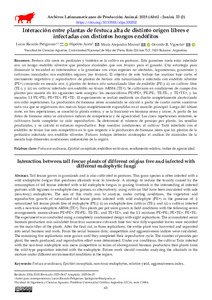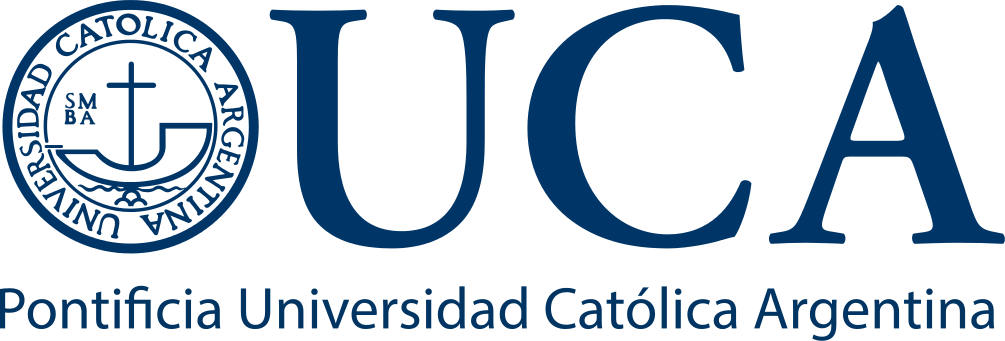Por favor, use este identificador para citar o enlazar este ítem:
https://repositorio.uca.edu.ar/handle/123456789/20234| Campo DC | Valor | Lengua/Idioma |
|---|---|---|
| dc.contributor.author | Petigrosso, Lucas Ricardo | es |
| dc.contributor.author | Arata, Hipólito | es |
| dc.contributor.author | Marino, María Alejandra | es |
| dc.contributor.author | Vignolio, Osvaldo R. | es |
| dc.date.accessioned | 2025-07-31T14:17:45Z | - |
| dc.date.available | 2025-07-31T14:17:45Z | - |
| dc.date.issued | 2025 | - |
| dc.identifier.issn | 2075-8359 | - |
| dc.identifier.issn | 1022-1301 | - |
| dc.identifier.uri | https://repositorio.uca.edu.ar/handle/123456789/20234 | - |
| dc.description.abstract | Festuca alta crece en pastizales y también se la cultiva en pasturas. Esta gramínea suele estar infectada con un hongo endófito silvestre que produce alcaloides que son tóxicos para el ganado. Una estrategia para disminuir la toxicidad es intersembrar a la gramínea con otras especies no afectadas, leguminosas, gramíneas y cultivares inoculados con endófitos seguros (no tóxicos). El objetivo de este trabajo fue analizar bajo corte, el crecimiento vegetativo y reproductivo de plantas de festuca alta naturalizada e infectada con endófito silvestre (PE+) creciendo en mezcla con: i) plantas de festuca alta naturalizada libre de endófito (PE) ; ii) un cultivar libre (TE), y iii) un cultivar infectado con endófito no tóxico AR584 (TE+). Se cultivaron en condiciones de campo dos plantas por maceta de los siguientes siete arreglos: los monocultivos PE+PE+, PEPE, TETE, y TE+TE+, y las mezclas 1:1 PE+PE; PE+TE+; PE+TE. El experimento se realizó mediante un diseño completamente aleatorizado con ocho repeticiones. La producción de biomasa aérea acumulada se calculó a partir de cuatro cortes sucesivos cada vez que se registraron dos nuevas hojas completamente expandidas en el macollo principal. Luego del último corte, en tres repeticiones, se cosechó la planta entera, y se la fraccionó en biomasa aérea y raíces. A partir de los datos de biomasa aérea se calcularon índices de competencia y de agresividad. Las cinco repeticiones restantes, se cultivaron hasta completar su ciclo reproductivo. Se determinó el número de panojas por planta, las semillas producidas, y se calculó el esfuerzo reproductivo. Bajo nuestras condiciones, el cultivar Taita infectado con el endófito no tóxico fue más competitivo en lo que respecta a la producción de biomasa aérea que las plantas de la población infectada con endófito silvestre. Futuros trabajos deberán contemplar el análisis de alcaloides de la mezcla bajo diferentes condiciones ambientales de la región. | es |
| dc.description.abstract | Tall fescue grows in grasslands and is also cultivated in pastures. This grass species is often infected with a wild endophytic fungus that produces alkaloids toxic to livestock. A strategy to reduce the toxicity caused by the consumption of tall fescue infected with wild endophyte fungus in grazing livestock is the interseeding of infected pastures with legumes or endophytefree grasses, or alternatively, using cultivars that have been inoculated with safe (nontoxic) endophytes. The aim of this study was to analyze, under cutting conditions, the vegetative and reproductive growth of naturalized tall fescue plants infected with wild endophyte (PE+) in the presence of: i) naturalized tall fescue plants free of endophyte (PE) ; ii) an endophytefree cultivar (TE) ; and iii) a cultivar infected with a nontoxic endophyte AR584 (TE+). Two plants per pot were grown in field conditions with the following seven arrangements: monocultures PE+PE+, PEPE, TETE, and TE+TE+, and the 1:1 mixtures PE+PE; PE+TE+; PE+TE. The experiment was conducted using a completely randomized design with eight replications. The accumulated aerial biomass production was calculated from four successive cuts each time two new fully expanded leaves were recorded on the main tiller of the plants. After the final cut, in three replications, the entire plant was harvested and separated into aerial biomass and roots. From the aerial biomass data, competition and aggressiveness indices were calculated. The remaining five replications were grown until they completed their reproductive cycle. The number of panicles per plant, the seeds produced, and reproductive effort were determined. Under our conditions, the cultivar Taita infected with the nontoxic endophyte was more competitive in terms of aboveground biomass production than plants from the wildtype population infected with the endophyte. Future work should consider analyzing the alkaloids in the mixture under different environmental conditions in the region. | es |
| dc.format | application/pdf | es |
| dc.language.iso | spa | es |
| dc.publisher | Asociacion Latinoamericana de Produccion Animal | es |
| dc.rights | Atribución-NoComercial-CompartirIgual 4.0 Internacional | * |
| dc.rights.uri | http://creativecommons.org/licenses/by-nc-sa/4.0/ | * |
| dc.source | Archivos Latinoamericanos de Producción Animal. 33(2), 2025. | es |
| dc.subject | FUNGICIDAS | es |
| dc.subject | HONGOS | es |
| dc.subject | FESTUCA | es |
| dc.subject | FORRAJES | es |
| dc.title | Interacción entre plantas de festuca alta de distinto origen libres e infectadas con distintos hongos endófitos | es |
| dc.title | Interaction between tall fescue plants of different origins free and infected with different endophytic fungi | es |
| dc.type | Artículo | es |
| dc.identifier.doi | 10.53588/alpa.330202 | - |
| uca.issnrd | 1 | es |
| uca.affiliation | Fil: Petigrosso, Lucas Ricardo. Pontificia Universidad Católica Argentina. Facultad de Ingeniería y Ciencias Agrarias; Argentina | es |
| uca.affiliation | Fil: Petigrosso, Lucas Ricardo. Universidad Nacional de Mar del Plata; Argentina | es |
| uca.affiliation | Fil: Arata, Hipólito. Universidad Nacional de Mar del Plata; Argentina | es |
| uca.affiliation | Fil: Marino, María Alejandra. Universidad Nacional de Mar del Plata; Argentina | es |
| uca.affiliation | Fil: Vignolio, Osvaldo R. Universidad Nacional de Mar del Plata; Argentina | es |
| uca.version | publishedVersion | es |
| item.languageiso639-1 | es | - |
| item.grantfulltext | open | - |
| item.fulltext | With Fulltext | - |
| Aparece en las colecciones: | Artículos | |
Ficheros en este ítem:
| Fichero | Descripción | Tamaño | Formato | |
|---|---|---|---|---|
| interaccion-plantas-festuca.pdf | 412 kB | Adobe PDF |  Visualizar/Abrir |
Este ítem está sujeto a una Licencia Creative Commons

